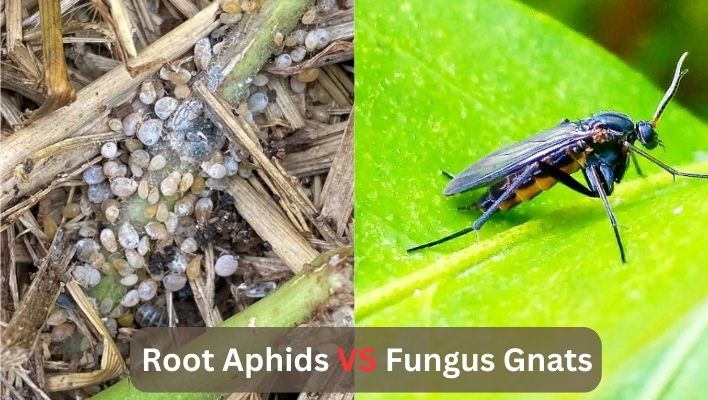Root aphids and fungus gnats are common pests that can affect plants in indoor and outdoor settings. While they may appear similar at first glance, it’s important to understand the differences between these two pests to identify and manage an infestation.
While both pests affect the roots of plants, they have different physical characteristics, life cycles, and habits. Important differences between the two pests are crucial to understanding how to manage and prevent infestations effectively.
In this article, we’ll provide a detailed comparison of root aphids vs fungus gnats, including their physical characteristics, life cycles, and methods for prevention and control. Read on to learn more about these pesky insects and how to keep them at bay.
What are root aphids?
Root aphids are tiny, soft-bodied insects that feed on the roots of plants. They can be white, brown, or black and range in size from 1-3 mm. Root aphids can be identified by their pear-shaped bodies, long antennae, and long legs. Unlike other aphids, they do not have wings and cannot fly.
Root aphids reproduce quickly and can produce up to six generations yearly. They reproduce asexually, meaning a single female can give birth to live young without mating. They also produce a waxy, protective coating that helps them to survive in the soil and resist insecticides.
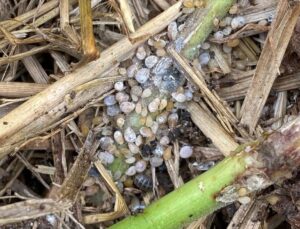
Signs of a root aphid infestation include wilting, stunted growth, yellowing leaves, and a sticky substance on the plant’s surface called honeydew. You may also notice small, white, or yellow aphids moving around the plant’s roots. Root aphids can cause severe damage to plants, as they feed on the plant’s roots and deprive it of nutrients and water. This can lead to reduced growth, weakened plants, and even death.
To identify root aphids in plants, gently dig around the roots and examine them closely with a magnifying glass. You may also notice signs of infestation on the plant’s leaves or stems. If you suspect your plants are infested with root aphids, it’s important to act quickly to prevent further damage.
What are fungus gnats?
Fungus gnats are small, dark-colored flies often found around houseplants or in greenhouse environments. They are about 1/8 inch long and have long, slender legs and wings. Fungus gnats are attracted to moist environments and feed on decaying organic matter, as well as the roots and stems of plants.
To identify fungus gnats in plants, you can look for the small, black flies flying around the plant or resting on the soil surface. You may also notice tiny, white larvae in the soil with a black heads and a long, slender bodies. These larvae feed on the roots of plants and can cause damage to young or weak plants.
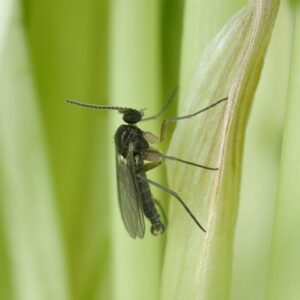
Fungus gnats have a life cycle of about 3-4 weeks when they lay their eggs in moist soil. The eggs hatch into larvae, which feed on the organic matter in the soil and plant roots. The larvae then pupate and emerge as adult gnats, which begin the cycle anew.
Signs of fungus gnat infestation include slowed plant growth, yellowing or wilting leaves, and a sticky substance on the plant’s surface called honeydew. You may also notice a musty odor around the plant, a sign of fungal growth that attracts the gnats. Fungus gnats can cause damage to plants by feeding on the roots, which can lead to reduced growth and weakened plants.
Root aphids vs. fungus gnats: similarities and differences
Root aphids and fungus gnats are both common pests that can cause damage to plants, but they have some important differences in their characteristics, life cycles, and the damage they cause. Here’s a table comparing and contrasting the two pests:

| Root Aphids | Fungus Gnats | |
|---|---|---|
| Appearance | Small, soft-bodied insects with pear-shaped bodies, long antennae, and long legs. Do not have wings. It can be white, brown, or black. | Small, dark-colored flies with long, slender legs and wings. About 1/8 inch in length. |
| Habitat | Found on plant roots and in soil. | Found in moist environments such as soil, decaying organic matter, and greenhouse environments. |
| Diet | Feed on the roots of plants, depriving them of nutrients and water. | Feed on decaying organic matter and the roots and stems of plants. |
| Reproduction | Produce a waxy, protective coating and reproduce asexually. It can produce up to six generations in a year. | Lay eggs in moist soil, which hatch into larvae that feed on organic matter and plant roots. Pupate and emerge as adult gnats. |
| Damage to Plants | Feeding on the roots can cause severe damage to plants and deprive them of nutrients and water. | It can cause damage to young or weak plants by feeding on the roots. It can also attract fungal growth that can harm plants. |
| Prevention and Control | Use sticky traps, insecticidal soap, or neem oil, and introduce natural predators such as ladybugs or lacewings. Avoid over-fertilizing plants. | Reduce soil moisture, use a well-draining potting mix, remove decaying organic matter, and introduce natural predators such as nematodes or predatory mites to the soil. Use sticky traps or insecticidal soap to control adult gnats if necessary. |
While both root aphids and fungus gnats can cause damage to plants, they have different diets and reproductive habits and require different prevention and control methods. By understanding the similarities and differences between these two pests, you can take steps to protect your plants and keep them healthy.
It’s important to differentiate between root aphids and fungus gnats because they require different control methods. For example, it won’t be effective if you have a fungus gnat infestation and apply an insecticide designed to control aphids. By understanding the differences between the two pests, you can take targeted steps to prevent and control infestations and keep your plants healthy.
Damage caused by each pest
Root aphids can cause significant damage to plants by feeding on the roots, depriving the plant of nutrients and water. This can lead to reduced growth, weakened plants, and severe plant death. In addition to causing direct damage, root aphids can transmit plant diseases, further weakening or killing the plant.
On the other hand, Fungus gnats primarily cause damage to plants by feeding on the roots, which can lead to reduced growth and weakened plants. The larvae of fungus gnats can also create wounds in the roots, allowing other pathogens to enter the plant and cause additional damage.
In addition, the larvae of fungus gnats can cause damage to young or weak plants, which can stunt growth or lead to plant death.
Overall, root aphids and fungus gnats can cause significant damage to plants if left unchecked. Preventing and controlling these pests’ infestations is important to keep your plants healthy and thriving.
How to prevent and control root aphids
Preventing and controlling root aphids can be challenging, but you can use several effective strategies. By understanding the signs and symptoms of root aphid infestation, you can take steps to protect your plants and keep them healthy. Here are some tips and techniques for controlling these pests:
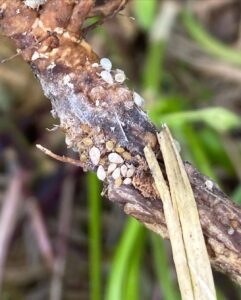
Prevention
- Use sterile soil or sterilize soil before planting to avoid introducing pests.
- Avoid overwatering, which can create conditions that favor pest growth.
- Monitor plants regularly for signs of pests, such as yellowing leaves or wilting.
- Quarantine new plants for a few weeks before introducing them to your collection.
- Keep a clean and tidy growing area to reduce the likelihood of pest infestations.
Chemical control
- Insecticides can be effective at controlling root aphids. However, they can also have negative impacts on beneficial insects and can be harmful to the environment.
- Always follow the instructions on the label carefully when using insecticides.
Non-chemical control
- Insecticidal soap or neem oil can effectively control root aphids without using harmful chemicals.
- Diatomaceous earth can create a barrier around plants to prevent pests from reaching them.
- Physical removal of heavily infested plant parts can also be effective in reducing the population.
Biological control
- Introducing natural predators, such as ladybugs or lacewings, can help control root aphids without using harmful chemicals.
- Nematodes and predatory mites can be introduced to the soil to control root aphid larvae.
It’s essential to choose a control method appropriate for your situation and the severity of the infestation. Chemical control methods should be used as a last resort, and non-chemical and biological control methods should be tried first. It’s also important to follow the instructions on the label carefully when using any control method to ensure safety and effectiveness.
How to prevent and control fungus gnats
Preventing and controlling fungus gnats is important for maintaining healthy plants. Here are some tips and strategies for managing these pests:
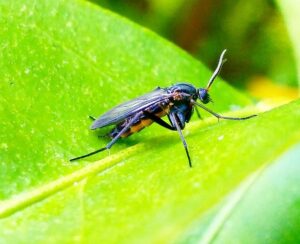
Prevention
- Avoid overwatering, which creates conditions that favor fungus gnat growth.
- Use well-draining soil to prevent water from pooling.
- Use yellow sticky traps to monitor for adult fungus gnats.
- Quarantine new plants for a few weeks before introducing them to your collection.
- Keep a clean and tidy growing area to reduce the likelihood of pest infestations.
Chemical control
- Insecticides can be effective at controlling fungus gnats. However, they can also have negative impacts on beneficial insects and can be harmful to the environment.
- Always follow the instructions on the label carefully when using insecticides.
Non-chemical control
- Sticky traps can be effective at catching adult fungus gnats.
- Beneficial nematodes, such as Steinernema feltiae, can be introduced to the soil to control fungus gnat larvae.
- Bacillus thuringiensis var. israelensis (Bti) can also control fungus gnat larvae.
Cultural control
- Allow the soil to dry out between waterings to reduce fungus gnat breeding.
- Apply a layer of sand to the soil surface to prevent adult fungus gnats from laying eggs in the soil.
It’s important to choose a control method appropriate for your situation and the severity of the infestation. Chemical control methods should be used as a last resort, and non-chemical and cultural control methods should be tried first. It’s also important to follow the instructions on the label carefully when using any control method to ensure safety and effectiveness.
Root Aphids vs Fungus Gnats FAQs
Can I eat plants infested with root aphids or fungus gnats?
Eating plants infested with root aphids or fungus gnats is generally not recommended. These pests can carry harmful bacteria and can also cause damage to the plants, which can affect their overall health and nutrition content.
Can root aphids and fungus gnats coexist in the same environment?
Yes, root aphids and fungus gnats can coexist in the same environment. However, it’s important to note that these pests have different life cycles and reproductive habits, so it’s important to properly identify the pest infestation to determine the best course of action for control.
How do you know if you have a root aphid or fungus gnat infestation?
To determine if you have a root aphid or fungus gnat infestation, you can look for signs and symptoms such as yellowing or wilting leaves, stunted growth, and a sticky or moldy soil surface. You may also see white or gray insects on the roots or soil for root aphids. For fungus gnats, you may see adult gnats flying around the plants or jumping larvae in the soil.
What is the best way to prevent root aphids and fungus gnats?
Good plant care practices are the best way to prevent root aphids and fungus gnats. This includes proper watering techniques, using well-draining soil, keeping the growing area clean and tidy, and monitoring new plants for pest infestations. Additionally, using sticky traps and introducing beneficial insects or nematodes can help prevent and control these pests without chemical treatments.
Conclusion
In conclusion, this article has provided a comprehensive overview of root aphids and fungus gnats, including their characteristics, life cycles, and the damage they can cause to plants. The article has also outlined the similarities and differences between these two pests and why it’s important to differentiate between them for adequate control.
Additionally, the article has provided tips and strategies for preventing and controlling root aphids and fungus gnats, including chemical and non-chemical control methods and biological control options.
Ultimately, understanding the differences between root aphids and fungus gnats is crucial for maintaining healthy plants and preventing damage. By following the prevention and control strategies outlined in this article, readers can effectively manage and control these pests in their growing environment.
Remember, good plant care practices are vital to preventing pest infestations, and early detection and proper identification are essential for adequate control.
